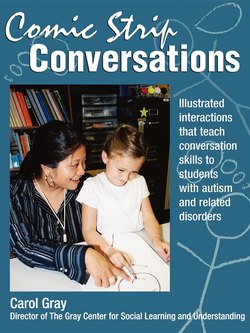Читать книгу Comic Strip Conversations - Carol Gray - Страница 6
ОглавлениеWhat is a Comic Strip Conversation?
A Comic Strip Conversation is a conversation between two or more people which incorporates the use of simple drawings. These drawings serve to illustrate an ongoing communication, providing additional support to individuals who struggle to comprehend the quick exchange of information which occurs in a conversation. Experience with Comic Strip Conversations indicates they may be an effective tool for parents and professionals working with students with autism and other developmental disabilities, although no objective data regarding the effectiveness of this approach is currently available.
While Comic Strip Conversations are as versatile as any other conversation, reporting the past, describing the present, or planning for the future, other characteristics of this approach are unique. Comic Strip Conversations systematically identify what people say and do, and emphasize what people may be thinking. A set of eight symbols are used to represent basic conversational skills. In addition, color may be incorporated to represent the emotional content of statements, thoughts, and questions. Some Comic Strip Conversations provide insights into a student’s perspective of a situation, and serve as an excellent prerequisite activity to the development of a social story (1). Comic Strip Conversations are also used to visually “work through” a problem situation and identify solutions.
Rationale
Comic Strip Conversations are based on the belief that visualization and visual supports, found useful in structuring the learning of students with autism (Grandin, 1992; Gray 1993; Odom & Watts, 1991; Twachtman,1992; Quill, 1991; Quill 1992), may also improve their understanding and comprehension of conversation. In addition” the use of a basic set of symbols are used in Comic Strip Conversations to illustrate social skills which are abstract and difficult for students with autism to understand.
(1) Social stories are short stories written for individuals with autism and related disorders to accurately describe social situations. In addition, social stories often identify effective responses to a given situation. See Reference section. Social story information and related materials are available from Future Education (address on this booklet.)
Students with autism have difficulty identifying the beliefs and motivations of others (Baron-Cohen, 1989; Baron-Cohen, 1990; Baron-Cohen, Leslie & Frith, 1985; Dawson & Fernald, 1987; Hobson, 1992). Comic Strip Conversations regard the thoughts and feelings of others as holding equal importance to spoken words and actions in an interaction. Students are taught to use colors to identify the feelings behind thoughts and spoken words.
Comic Strip Conversations originated in part from the communicative drawings of a ten year old girl, Larkin. Larkin would draw to communicate frustrating situations to her mother, Teri, who would draw in return. In Teri’s words:
My daughter uses a kind of “social stories” process to talk her way through difficult situations. She draws or has someone else draw situations that have been confusing or distressing to her. We have learned to not only draw the disturbing situation she requests, but also to draw the sequence of events that leads to an appropriate conclusion to the situation.
Larkin takes great comfort from these drawings and can then use that information to help herself in future similar situations. We have taken her lead and used this method to help her develop coping skills. My drawings are always in response to Larkin’s drawings - unless she is just too agitated about a situation and insists that I draw the situation for her - then I still follow up with my conclusion -sometimes accompanied by a cryptic “social story”.
Building from Larkin’s example, a systematic approach to conversing with drawings was developed with the help of Matthew, an 11 year old in the fifth grade. Guidelines for the Comic Strip Conversation approach were established and piloted. Modifications were made incorporating Matthew’s feedback and current social cognition and theory of mind research. A dictionary of eight basic symbols for conversation skills was developed, and color was incorporated to provide a visual system to identify the emotional content of conversation.
The basic guidelines in this booklet reflect the efforts of students, parents, and professionals who have worked to develop Comic Strip Conversations. Intended as guidelines, they provide a starting point for helping each student develop their own individual "art of conversation”.
Materials
Participants in a Comic Strip Conversation draw as they talk, which requires the selection of drawing and writing materials prior to beginning each conversation. There are several different materials which may be used, each with advantages and disadvantages. The following list of materials describes their advantages and disadvantages in a Comic Strip Conversation. Based on the knowledge of an individual student, including the expressed preference of the student, materials which are most likely to be effective are selected. Materials may be creatively combined to meet a given situation, and a student’s needs and interests.
Laminate Marker Boards
Laminate marker boards (with specially designed markers and erasers) are increasing in variety and popularity. Many classrooms are now equipped with laminate marker boards, which in many cases have replaced chalkboards. They are available in office supply stores in a wide range of sizes. They come in two colors, white and black. The white boards may be used with markers which come in a wide variety of colors. The black boards are intended for use with fluorescent markers which are available in only a few basic colors.
The advantage of laminate boards is that they provide a great deal of flexibility. Laminate boards make it easy to erase and make changes. In addition, the wide variety of marker colors available make it easy to represent several different feelings using color (see section “Feelings and Color). Black laminate boards offer a limited range of fluorescent colored markers, though the use of these bright colors on the black background may be more effective in holding the interest of some students.
